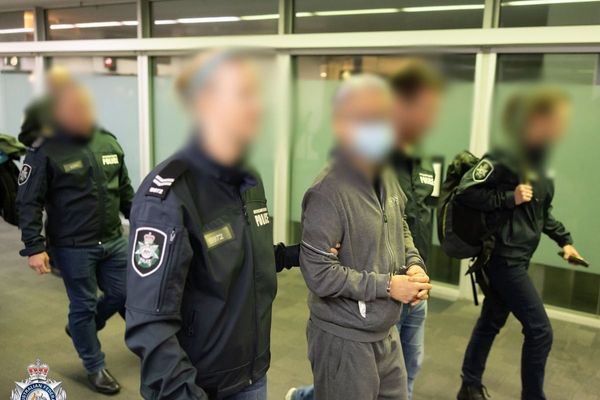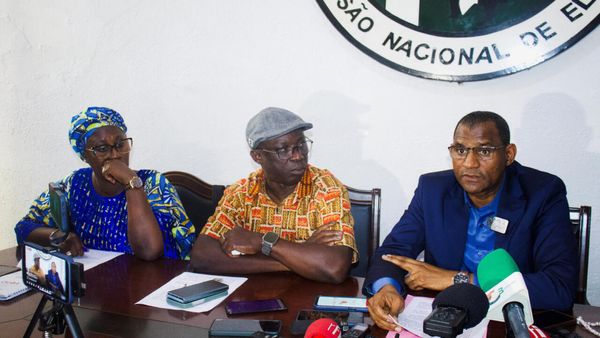
Beirut, Lebanon – The Houthis, the most prominent group in Yemen, have seen their popularity soar in the region after their attacks on Israel-linked ships in the Red Sea threatened to disrupt a major global maritime route.
In recent weeks, the Iran-linked group has mobilised hundreds of thousands of people to the streets of Yemen’s capital Sanaa for Friday rallies in support of Gaza. Internationally, the group’s profile has grown after being on the receiving end of United States and United Kingdom air strikes for disrupting Red Sea shipping, an act they say is in support of Palestinians suffering Israeli aggression in Gaza.
But the Houthis are not the only force in Yemen; in fact, they are not Yemen’s internationally recognised government.
How did the Houthis rise to prominence?
In September 2014, the Houthis overran Sanaa and captured vast swaths of the country, forcing then-President Abd-Rabbu Mansour Hadi to flee.
In March 2015, a nine-country coalition led by Saudi Arabia intervened on behalf of the Hadi government. That war plunged Yemen into what the United Nations called “the world’s worst humanitarian crisis”.
A truce on April 2, 2022, quietened the guns. Today, the Houthis control most of Yemen’s west.
The Presidential Leadership Council
Five days after the truce, Hadi resigned and handed over his authority to the Presidential Leadership Council (PLC), an eight-member council that included several major Yemeni figures.
The PLC, backed by Saudi Arabia and the United Arab Emirates, is the biggest counterweight to the Houthis in Yemen.
“The objective was to utilise this council [PLC] to engage with the Houthis either militarily or through negotiations,” Raiman al-Hamdani, a Yemen researcher at the ARK Group, told Al Jazeera.
“Furthermore, the PLC provides legitimacy to various armed groups that have operated without formally falling under the government’s command.”
But the PLC’s union is one of convenience in opposing the Houthis and the group has many competing and, at times, incompatible differences, within it.
“The PLC seldom reaches unanimous agreement,” al-Hamdani said, “often needing guidance from their foreign backers on the best position to take.”
So who are the groups that make up the PLC?
The Southern Transitional Council
Major General Aidarus al-Zoubaidi, a former governor of Yemen’s second city Aden, is the leader of the 26-member STC and sits on the PLC.
Other members of the STC are government ministers and governors from southern Yemen.
Their armed forces are backed by the United Arab Emirates, as Abdullah Baabood wrote for the Malcolm H Kerr Carnegie Middle East Center.
It currently controls southwest Yemen but has greater ambitions – including secessionist goals for southern Yemen. “They want all of old South Yemen,” Yemen analyst Nicholas Brumfield told Al Jazeera, referring to South Yemen which was merged with the North in 1990.
“Over the last several years, whenever there was a lull in fighting with the Houthis, the main story in Yemen was the STC fighting with the government of Yemen or al-Islah [an Islamist group that dominated the Yemeni government until 2019] to try and take eastern Yemen.”
But the STC is trying to temper its secessionist aims in a bid to fight the Houthis and maintain regional support.
The Giants Brigades
Also known as the Southern Giants Brigades or “al-Amaliqah”, are a pro-government armed group predominantly made up of southern Yemeni tribesmen who also have separatist goals for the south.
The group has more than 15,000 fighters led by Abd al-Rahman Abu Zaraa Al-Muharramii. Experts on Yemen believe it is backed by the UAE.
They are particularly active in the Taiz governorate, north of Aden.
Saleh and the Guardians of the Republic
The nephew of the late President Ali Abdullah Saleh, Tariq Saleh, controls a group known as the Guardians of the Republic. His troops comprise ex-special forces personnel who were close to his uncle.
Saleh is also backed by the UAE, according to Baabood, and his troops allegedly received training at an Emirati military base in Assab, Eritrea.
They are based in al-Makha (Mocha) on the western coast.
Al-Islah
“[Al-Islah] are an Islamist group and dominated the internationally recognised government for the majority of the conflict until 2019,” al-Hamdani said. Two members of al-Islah, which Yemen experts believe is backed by Saudi Arabia, sit on the PLC.
The first is Sultan Ali al-Arada, governor of Marib – an area where the Houthis are building up troops.
The second is Abdullah al-Alimi Bawazeer, who was close to Hadi.
Al-Islah has clashed with many of the members of the PLC before, including the STC.
“The towns in the north that are controlled by the government [Marib, Taiz] are Islah-dominated. In the South, the UAE has in most places driven them out,” al-Hamdani added.
Individual members
Other members include its head Rashad al-Alimi, Saada tribal leader and lawmaker Othman Hussein Majali; and Faraj Salmin al-Bahsani, the former governor of eastern Yemen’s Hadramout and a former military officer.
Will the Houthis be able to withstand the PLC?
After years of fighting, the Houthis’ military capabilities – initially rudimentary – have become more sophisticated, At the same time, the PLC has not been completely united, and internal disagreements among its members have played into the Houthis’ hands.
The members have conflicting ambitions and ideologies and before the formation of the PLC in 2022, some had clashed militarily. These divisions have allowed the Houthis to maintain control over important territory and put themselves forward as a legitimate actor in negotiations over a ceasefire with Riyadh.
Their armoury is a mix of Iranian sniper rifles, AK-47 assault rifles from China and Russia, and rocket-propelled grenades built in Bulgaria and North Korea. “The majority of their arms are of Russian, Chinese or Iranian origin, but North Korean weapons and those produced in former Warsaw Pact countries are also present in the arsenal,” NR Jenzen-Jones, the director of the Australian-based Armament Research Services, told Voice of America.
International parties fighting the Houthis
The two main regional actors that have been fighting the Houthis are Saudi Arabia and the UAE. Both groups back the PLC, but are aligned with different forces within the coalition.
The UAE has backed the STC, as well as other PLC members including the Giants Brigades and Saleh. Saleh and the STC have both “been loud about their vital positions in stopping the Houthis’ attacks [on shipping vessels in the Red Sea]”, said Brumfield.
Saudi Arabia has thrown its weight behind figures who wanted a unified Yemen in the PLC, including Chairman al-Alimi, and al-Islah, which has two members of the PLC board.
The Saudis “aim to avoid being remembered for dividing Yemen,” al-Hamdani said. One point of contention arose between Saudi Arabia and UAE when the STC threatened to push into the area along the porous Yemen-Saudi border that accounts for most of Yemen’s oil production. “The Saudis are very protective and don’t want anyone, even the Emiratis, having a group controlling the Yemen side,” Brumfield said.
But, Brumfield said, those disagreements seem to have cooled in recent months as “the UAE appears to have recognised Yemen is just much more important to Saudi Arabia than to them”.
That importance, however, doesn’t mean they want to stick around in the country indefinitely, he added. “Saudi Arabia is really desperate to get out of Yemen.”







